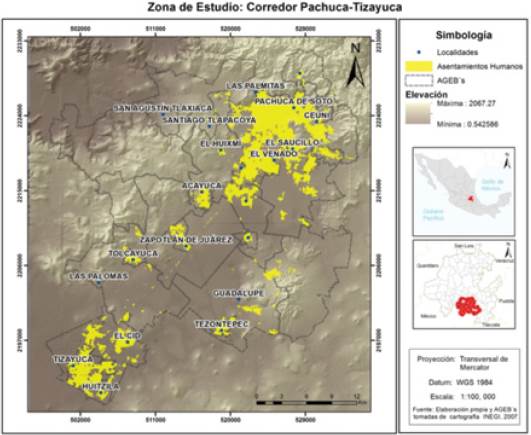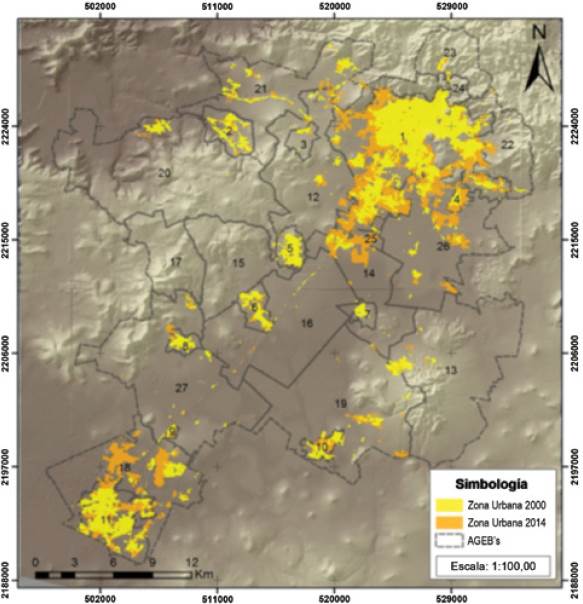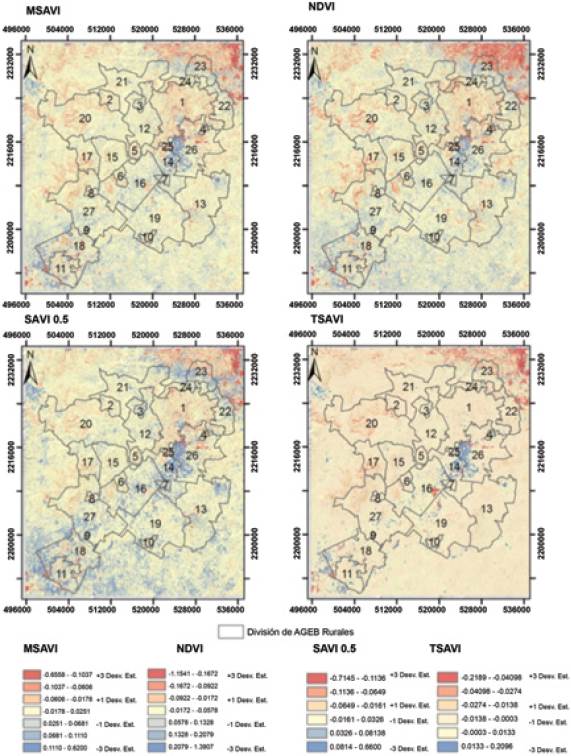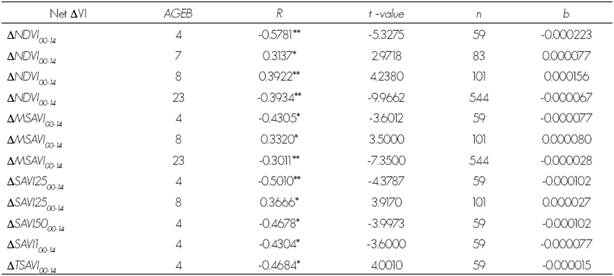Services on Demand
Journal
Article
Indicators
-
 Cited by SciELO
Cited by SciELO -
 Access statistics
Access statistics
Related links
-
 Similars in
SciELO
Similars in
SciELO
Share
Revista mexicana de ciencias forestales
Print version ISSN 2007-1132
Rev. mex. de cienc. forestales vol.7 n.33 México Jan./Feb. 2016
Articles
Influence of urbanization on the change in the vegetation adjoining the Pachuca-Tizayuca corridor (2000-2014)
1Centro de Investigaciones Químicas, Universidad Autónoma del Estado de Hidalgo México. Correo-e: lwz.flores@gmail.com
2Instituto de Ciencias Agropecuarias, Universidad Autónoma del Estado de Hidalgo, México.
Urban areas exert pressure over the adjoining vegetation. It has been demonstrated that the difference between vegetation indices (ΔVI) is a good indicator of its deterioration; however, no methodology quantifying its impact has been established. This strategy was applied in the main municipalities of the Pachuca-Tizayuca Valley, where urbanization experiences greater growths. The supervised classification was obtained in the years 2000 and 2014 through geographical information systems (GIS) and Landsat images (> 80 % reliability). The change of use of the soil (NU) to urban (U) was determined using the U/NU ratios and comparing them with the ΔVI between the two years. The NDVI, MSAVI, SAVI and TSAVI indices and the rural AGEBs were utilized as geographical analysis units. A distance raster file was generated for every pixel at the edge of the nearest urban areas (DU). The linear correlation of DU was determined using the ΔVI based on the bivariate spatial regression in IDRISI-Taiga software. The AGEBs with growing urbanization were identified by the higher values of the U/NU ratio; the ΔVIs were also observed to have higher values. DU was shown to have more correlation with ΔVI in the AGEBs with human settlements of intermediate expanse (R2 of 0.1 to 0.33). And the spatial correlation of ΔVI vs. DU has been equally proven to be a good methodological strategy for estimating the impact of urban pressure on the vegetation adjoining human settlements.
Keywords: Basic geographic area; human settlements; change in land use; spatial correlation; vegetation index; urban pressure
Las áreas urbanas ejercen presión sobre la vegetación colindante a estas. Se ha demostrado que la diferencia en los índices de vegetación (ΔIV) es un buen indicador de su deterioro; aunque se relaciona con la presión urbana, no se ha establecido una metodología que cuantifique su impacto. Esta estrategia se aplicó en los principales municipios del Valle de Pachuca-Tizayuca, en donde la urbanización registra mayores crecimientos. Se obtuvo la clasificación supervisada en los años 2000 y 2014, mediante sistemas de información geográfica e imágenes Landsat (confiabilidad > 80 %). Se determinó el cambio de uso de suelo (NU) a urbano (U) con los cocientes U/NU y se compararon con ΔIV entre ambos años; se usaron los índices NDVI, MSAVI, SAVI y TSAVI; además de los AGEB rurales, como unidades geográficas de análisis. Posteriormente, se generó un archivo raster de distancias de cada pixel al borde de las zonas urbanas más cercanas (DU). La correlación lineal de DU se determina con el ΔIV a partir de la regresión espacial bivariada en IDRISI-Taiga. Las AGEB con creciente urbanización se identifican por los valores mayores del cociente U/NU y se observa que los ΔIV presentan mayores valores. Se demuestra que DU tiene más correlación con ΔIV en las AGEB con asentamientos humanos intermedios en expansión (R2 de 0.1 a 0.33). Se demuestra que la correlación espacial ΔIV vs. DU es una buena estrategia metodológica para estimar el impacto de presión urbana sobre la vegetación colindante a los asentamientos humanos.
Palabras clave: Área geográfica básica; asentamientos humanos; cambio en vegetación; correlación espacial; índice de vegetación; presión urbana
Introduction
Change in land use processes have become more acute in Mexico since the second half of the XXth century, and this has had a direct impact on the vegetal coverage. Two of the factors with greatest impact are human settlements and urban areas (Cuevas et al., 2010). Forest ecosystems are being increasingly damaged by anthropic pressure; for this reason special attention must be paid to the study of the effects of urbanization on the environment (Jenerette et al. 2007). In certain areas of Mexico, there has been a high rate of change to an urban land use within short periods (Pineda-Jaimes et al., 2009).
It is important to carry out research on the interaction between urbanization and its impact on the dynamics of vegetation in order to avoid the deterioration of the vegetal cover (Cuevas et al., 2010). In contrast, settlements adjoining these ecosystems benefit from the regulations, supplies and entertainment services that they afford. Therefore, the areas that are most susceptible to influence or which have most interaction within the dynamics of the vegetation must be identified in order to provide information to public policy makers for its protection. Vegetation indices (VI) can be useful descriptors for these analyses.
Vegetation indices are values based on reflectivity measures at different wavelengths (usually in the red and infrared regions) that provide numerical parameters for the biomass and quantify the amount or vigor of the vegetation with minimal disturbances for the soil and the atmosphere (Bannari et al., 1995; Torres et al., 2014). This is possible because the reflection bands of the leaf in the near infrared spectrum depend upon the structure of the leaf; therefore, the modifications due to ripeness, stress, lack of moisture, strength and distribution are measureable.
The VIs are classified based on the way in which they are estimated: a) through the arithmetic combination of the red and infrared bands of the soil slope as the normalized index (NDVI); b) using the land base line as the reference parameter for the distance of the vegetation to the urbanized area, the ordinary soil-adjusted index (SAVI), or the modified soil-adjusted index (MSAVI); c) the sets of unadjusted orthogonal bands, including the main components index (PVI).
In Mexico, the deterioration of the vegetation has been analyzed through the multitemporal change of the VIs, particularly in forest ecosystems in Nuevo León (Pérez-Morales, 2014), and at a national level (Meneses-Tovar, 2011; Galicia et al., 2014); researches carried out in Pinus and Pinus-Quercus forests; the national analysis includes high rain forest, low rain forest, mesophylic forest, mangrove, shrubland, grassland and desert. In all of them, the NDVI is the most widely used index.
An innovative aspect has been the evaluation of the effect of urbanization on the vegetation based on the change in the vegetation indices and their correlation to the population density (Jenerette, 2007; Li et al., 2014; Levin, 2015), the income of the population (Martin et al., 2004), the distance to the routes of communication (Li et al., 2014), and the urbanized area (Sun et al., 2011). This strategy is based on the systematic measurement of the VIs in order to monitor the dynamics of the vegetation as a result of the transition between different uses of the soil, specifically urbanization.
However, there are no documented methodologies that allow measuring whether the change in the VIs is especially related to the nearness of the urban areas.
Whether or not this correlation serves as a method to learn, through spatial analysis techniques, that there is an association between the susceptibility of the vegetation due to the vicinity of urban areas and to their rapid growth needs to be verified. For this reason, the Pachuca-Tizayuca corridor was selected for a case study to test this methodological proposition, since its municipalities have high rates of urban growth.
Materials and Methods
a) Physical location and characteristics of the study área
The study area is located in the south of the state of Hidalgo and comprises the municipalities of Pachuca, Mineral de la Reforma, Zapotlán de Juárez, Villa de Tezontepec, Tolcayuca, Tizayuca and part of San Agustín Tlaxiaca and Zempoala (Figure 1), with a total surface area of 964.45 km2 (Figure 1).
In physiographical terms, the region is part of the Transversal Neovolcanic Axis province, with topoforms that include mountain chains, plains and rolling hills (Inegi, 2014). Most of the mountain chain area is located to the north, and a small part of it is south of the area (Inegi, 2014). That system is formed by andesitic and dacitic volcanic rocks corresponding to the Tertiary period (SGM, 2007). The rolling hills are situated in the northeast (Inegi, 2014), in Mineral de la Reforma; they are made up of andesite, dacite and dacitic tuff. The plains are located in the central and southern portion, coinciding with the majority of the human settlements; they have a NNE- SSW orientation and are constituted by volcano-sedimentary material from the surrounding sierra and rolling hills (SGM, 2007). They are part of the hydrographic area of the Pánuco river (EH26) and belong to the basin of the Moctezuma river. The predominant climate is semi-dry temperate and sub-humid temperate (Inegi, 2008).
The vegetation is represented by xerophyllic shrubs and induced grasslands. The former are distributed in the periphery of the valley, mainly on the Cubitos mountain, and include species in the NOM-059-SEMARNAT-2010 norm, such as Coryphantha werdemannii Boed., Turbinicarpus pseudomacrochele ( Backeb.) Buxb. & Backeb., considered in the Endangered Species category; Astrophytum ornatum (DC) Britton & Rose, Cephalocereus seniles (Haw.) Pfeiff., Ferocactus stainesii (Salm-Dyck) Britton & Rose var. pilosus (Galeotti ex Salm- Dyck) Backeb., Mammillaria klissingiana Boed., Mammillaria longimamma DC., Mammillaria zephyranthoides Scheidw., classified as Threatened, and Coryphantha durangensis (Runge ex Schum.) Britton & Rose, Coryphantha radians Britton & Rose, Coryphantha retusa Britton & Rose, Echinocactus platyacanthus Link & Otto, Echinocereus pulchellus (Mart.) K. Schum., Ferocactus histrix (DC.) G.E. Linds., Stenocactus coptonogonus (Lem.) A. Berger ex A. W. Hill, Thelocactus leucacanthus (Zucc. Ex Pfeiff.) Britton & Rose, under Special Protection (Zuria and Rendón, 2010).
The forest vegetation is distributed in the north of the study area, within the El Chico National Park, and consists of Sacred fir (Abies religiosa (Kunth) Schltdl. & Cham.), Mexican juniper (Juniperus monticola Martínez) and, to a lesser extent, oak (Quercus spp.) forests. According to the NOM-059- SEMARNAT-2010 norm, Pseudotsuga macrolepis, Taxus globosa and Litsea glaucescens are classified as Endangered, and Fucrea bendinghaussii, as Threatened (Conanp, 2005).
In order to determine the impact of rapid urbanization on the natural ecosystem adjoining the Pachuca-Tizayuca corridor, territorial units were established upon the basis of the Rural Basic Statistical Geographical Area (AGEB) defined by Inegi (2007). This division was selected because it reflects homogenous socioeconomic characteristics, it takes into account municipal boundaries, and the size of the areas allows a more detailed analysis of the territory than the municipal level.
The ratio of the urban sprawl to the difference between the vegetation indices (ΔVI) and was compared to the distance to human settlements (DU); for this purpose, the following actions were carried out: a) the urbanized area was determined for the years 2000 and 2014; b) the climatic context of the area was analyzed to evaluate the comparability between those years; c) the VIs and the differences between the two years ΔVI00-14 were estimated, and the urban sprawl for was compared between the AGEBs, and d) the correlations between the ΔVI and the DU were determined.
b) Estimation of the urban sprawl between 2000 and 2014
Three multispectral Landsat ETM and OLI images -Path-Row 26/46- of February 2000 and 2014 from the website of the United States Geographical Service (USGS), with a pixel resolution of 30 m on a side, were used. They were geometrically corrected using control points obtained from orthophotos (scale 1:75 000). Next, the radiometric (Chander et al., 2009) and atmospheric calibrations were carried out using the ENVI 5.1 software and the FLAASH (Fast Line-of- sight Atmospheric Analysis of Spectral Hypercubes) correction developed by Kruse (2004), as proposed by Arias et al. (2015), in order to convert the digital levels into radiance values and, subsequently, to normalized reflectance values, which can be contrasted between different periods (Hantson et al., 2011).
The supervised classification was based on the 80 areas of training that were known or had been verified in the field. This is a widely used method to classify the cover and land use in Mexico (García-Mora and Mas, 2008; Figueroa-Jáuregui et al., 201), based on the establishment of reflectance values which the classification groups by maximum plausibility using the IDRI Taiga software, whose performance in the detection and modeling of the change of land use is very good, unlike other techniques (Mas et al., 2014).
Its effectiveness was evaluated using confusion matrices, based on random samples with 400 and 300 verification points for 2000 and 2014, respectively, since large populations (>10 000) do not require a sample above 100 (Mas et al., 2003).
The SAMPLE module of the IDRISI software was utilized, taking its ground truth as a basis for field visits as well as Google Earth images and orthophotos (Inegi, 1999). The omission and commission errors were estimated for 10 classes of land cover: water, secondary forest, conifer forest, fallow land, eroded areas/areas without vegetation, urban area, cultivated land, open and altered shrublands, dense and healthy shrublands, and natural and induced grasslands. The standard deviation (≤ 0.05) was estimated based on the sample size and on the percentage of confidence interval, as recommended by Mas et al. (2003). The classified images were filtered and converted into polygons in order to estimate the urban areas of 2000 and 2014 and their differences.
c) Description of the climatic context of the area
This work is part of a series of evaluations carried out during the same period -e.g. one month (Morawitz et al., 2006) or more (Levin, 2015)- in different years in order to measure the variations in the vegetation beyond seasonality (Benliay and Altuntaş, 2014). For this reason, the climatic tendencies of average annual precipitation and temperature parameters of the climatological stations within and on the edges of the study area were found and their location is described in Table 1.
Table 1 Climatological stations utilized to describe the climatic context of the area.
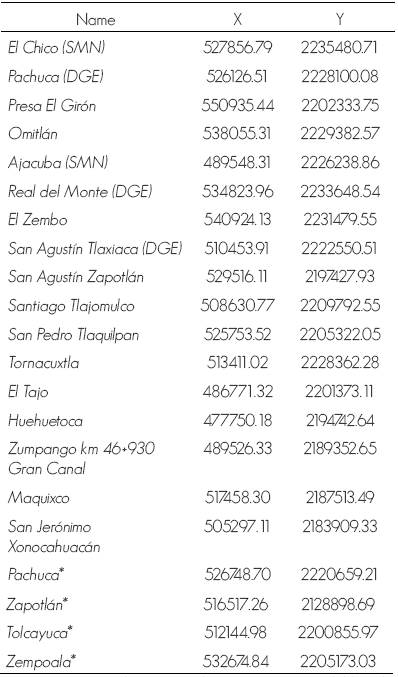
SMN= Servicio Meteorológico Nacional; DGE=Dirección General del Estado.
*Climate stations of INIFAP
The data from the stations between 1980 and 2014 were used. Based on their variances, it was determined whether or not the conditions of precipitation and temperature in the years 2000 and 2014 are comparable, since these have been shown to be the factors that most influence changes in the vegetation (Mao et al., 2012). Thus, the effect of the changes in the vegetation caused by the climatic factors in the correlation between ΔVI00-14 and DU are considered.
d) Calculation of the difference between the vegetation indices in 2000 and 2014 and comparison between urbanization in each AGEB
Different VIs were calculated for the whole study area with the equations described in Table 2, using the ENVI 5.1 software.
Table 2 Vegetation indices and their application in the study area.
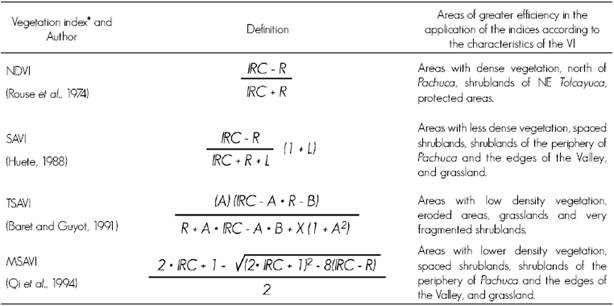
*NDVI = Normalized Difference Vegetation Index; SAVI = Soil Adjusted Vegetation Index; TSAVI = Transformed Soil Adjusted Vegetation Index, MSAVI = Modified Soil Adjusted Vegetation Index; IRC = Near infrared band; R = Red band; L = Parameter consisting in a soil-adjusted constant, and X allowing to minimize the maximum soil effect.
For the TSAVI index, the soil line was defined according to Eastman (2009), who describes how to estimate the slope and the intercept of the values of the soil line based on a regression between the values of the pixels on the naked soil in relation to the values of the red or infrared band.
Once the indices were calculated, the main differences between the VIs were estimated, using the raster calculation for the evaluated years. The rasters resulting from the difference between the VIs (NDVI, SAVI, MSAVI, TSAVI) in the period 2000 and 2014 were denominated ΔVI00-14.
The mean values of the ΔVI00-14 for each AGEB were estimated and compared to the proportion of urbanized surface area in each AGEB by means of charts in order to determine whether or not there is a relationship between the increase in urbanization and the ΔVIs00-14 (Morawitz et al., 2006; Dhorde et al., 2012).
e) Spatial correlations between the VIs and the distance to the urban áreas
The ΔVI vs. DU correlation was estimated using a bivariate spatial regression, with the REGRESS command of the IDRISI Taiga software (Eastman, 2009). In order to measure it, a Boolean raster file was generated for each analysis unit (AGEB), and 10 % of the pixels were randomly extracted from each. In order to rule out the existence of a self-correlation, "Moran's I" test was applied, using the SELF CHECK command of the same software.
Next, the AGEBs in which the ΔVI has the highest correlation to DU were identified, determining the sign of this correlation, in which the dependent variable is the DIV and the independent variable is DU.
Results
a) Supervised classification
It consists in differentiating the urban area from other types of vegetal covers. In the case of the classification for the year 2000, the average omission and commission errors were of 0.17 and 0.15, respectively. Table 3 summarizes the reliability data for the entire confusion matrix. The average value was 0.83, and therefore the defined urban areas are reliable.
Table 3 User's and producer's reliability for the soil cover categories classified for 2000 and 2014.
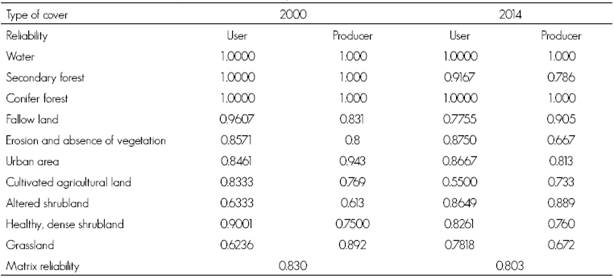
For the year 2014, the classification had an omission error of 0.13 and a commission error of 0.14. The average reliability of the classification was 80.3 % (Table 3). Based on these values, the urban area has grown by 51 % in the municipality of Pachuca, by 138 % in Mineral de la Reforma, and by 41 %, 13 % and 88 % in Villa de Tezontepec, Tolcayuca and Tizayuca, respectively.
Figure 2 shows the map of the growth of the urban sprawl in the study area between the years 2000 and 2014.
b) The years 2000 and 2014 within the climatic context of the area
The mean temperature was 14.82 ± 0.42 °C. A tendency ranging between 14.6 °C, in 1980, and 15.0 °C, in 2014, was observed; therefore, in the last 30 years there has been a warming of 0.4 °C (Figure 3).
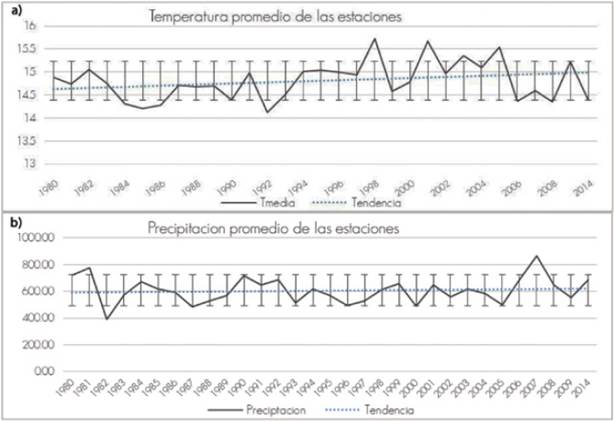
Source: Temperature (a) and precipitation (b) data from the existing climate stations of the NMS from 1980 to 2009. Except for 2014, which is an average of the climate stations of INIFAP, since the NMS only has information available for the period from 1980 to 2010.
Figure 3 Temperature (a) and precipitation (b) data from annual measurements through 30 years (1980-2014).
During the studied period, the mean temperature in the year 2000 was 14.8 °C for a variation of under 0.2 °C; it is therefore assumed that this variation did not affect the vegetation.
The mean precipitation value was 604 ± 95 mm, with a high standard deviation; this is indicative of the most disperse, unpredictable behavior of this parameter. For example, in the year 2007 there was an extreme event with high precipitations, a factor which may have influenced the results of the estimated ΔVls00-14.
c) Preliminary assessment of ΔVIs adjoining urbanization in each AGEB
The estimated ΔVIs show in which of the 27 AGEBs there was a coincidence with the growth of urbanization, as well as the changes in each of the estimated ΔVIs between the years 2000 and 2014 and their sign (Figure 4). The units with greatest impact on the vegetation were AGEBs 4, 7, 1, 14, 18, 25 and 26; of these, only AGEB 4 suffered a negative impact.
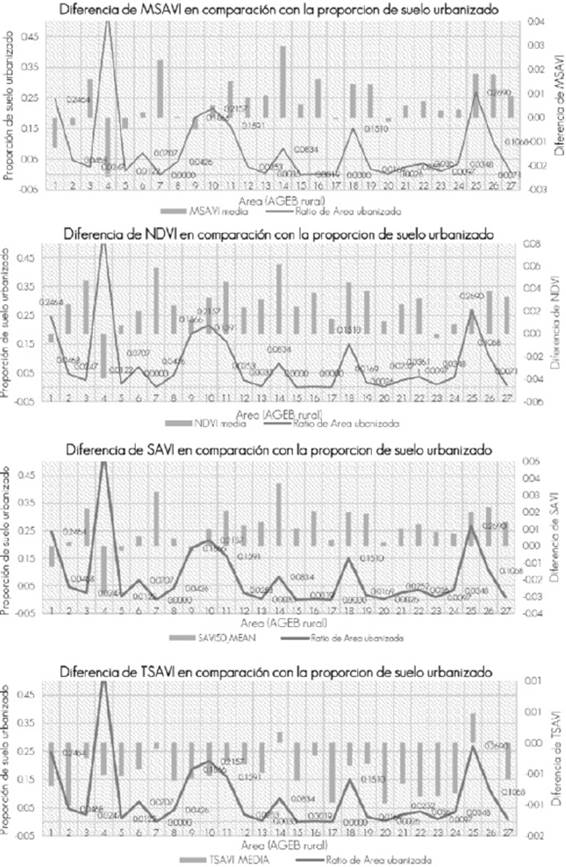
Figure 4 Positive and negative differences between the VIs compared to the urbanized soil. (AGEB on the X-axis. Proportion of urbanized soil (U/UN ratios) by AGEB and ΔVIs on the Y-axis).
The urban sprawl was observed to have grown considerably in 10 AGEBs; in these cases, the DIV was not always negative.
Unfavorable relationships between the ΔVI and the U/NU urbanization ratio. In the AGEBs in which the urbanized area grew, the ΔVI was negative. These areas correspond in general to the settlements, towns and cities (Pachuca, AGEB 1; the Mineral de la Reforma residential developments, AGEB 4, and Tizayuca, AGEB 9), which have spread over the native vegetation or are due to the use of the shrublands and grasslands, as in the municipality of Zapotlán de Juárez (AGEB 6, TSAVI).
Favorable relationships between the ΔVI and the U/NU urbanization ratio. These occurred in the AGEBs whose cultivation areas have expanded and which have positive ΔVIs, despite urbanization. This is evident, especially in the southern residential developments of the Pachuca municipality (AGEB 25) and of Mineral de la Reforma (AGEB 26), and, to a lesser degree, in Jagüey de Téllez (AGEB 14), El Cid (AGEB 18), Villa de Tezontepec (AGEB 10) and Tizayuca-Huizila (AGEB 11).
Figure 5 includes the maps with the location of the AGEBs for each estimated ΔVI. Increases in the ΔVIs -e.g. those sites where the vegetation has recuperated- are highlighted in blue; ΔVI losses are highlighted in red.
d) Spatial correlations between the ΔVIs and the DU distance to the urban areas
The correlation between the ΔVIs and the DU was estimated for each analysis unit (AGEB). The self-correlation in each was ruled out using Moran's I test, which gave as a result an average value of 0.07. This means that the proximity of the extracted pixels did not produce a specification error.
Table 4 shows the linear regression parameters of the correlations that turned out to be significant and have higher R-values for the net values of ΔVI vs. DU.
Discussion
The estimated correlations are valid in the spatial analyses such as were applied in the present study, an example of which are the studies citing correlations between urbanization- related variables (population density, distance to the urban infrastructure, average income) and ΔNDVI with R-values between 0.225 and 0.381 (Li et al., 2014). An R-value of 0.6 was also obtained for the correlation between the urban population density and ΔNDVI (Morawitz et al., 2006), or between socioeconomic aspects and ΔVI with R-values of 0.14 to 0.32 (Mennis, 2006). In this paper, R-values are higher than these and similar to those indicated by Jenerette et al. (2007) and Levin (2015).
The influence of the distance to the urban areas on the VIs as the main parameter describing their change, ΔVI, was analyzed using ΔVI and DU values. From the results listed in Table 4, it is evident that AGEBs 4 and 23 had a greater impact on the vegetation adjoining its urban areas, while AGEB 8 did not show the same tendency.
AGEB 4 (residential developments of Mineral de la Reforma municipality) registered a negative linear correlation with the DU for the four evaluated indices; this means that, in general, the nearness of urban areas entails a decrease in the quality of the vegetation. It is observed that the values of the moderate correlation coefficients R range between -0.43 and -0.57. AGEB 23 also showed negative correlations only with MSAVI and NDVI, whose R-values were -0.30 and -0.39, because the vegetation in this area is dense.
In AGEB 8 (Tolcayuca), the correlations were positive and significant, except with TSAVI, in response to the presence of dense shrubland areas, for this index is representative of scattered vegetation areas. AGEB 7 alone registered a significant correlation with the NDVI because the cultivated area increased between 2000 and 2014. The positive change in the ΔVIs occurred mainly in areas that are far from the urban areas.
The values of the slopes (β1) turned out to be low because they multiply the distance, expressed in meters, and therefore, their interval ranges between 0 and 20 000. Values are higher in AGEB 4; i.e. the vegetation is much more sensitive to the nearness of the urban area than other AGEBs. Likewise, AGEB 8 had the highest slope value in the regression with the NDVI. The highest slope values were obtained with this ΔVIs. Other VIs respond to the change and can describe it, but they are not as sensitive as the NDVIs in the studied areas.
It must be considered that the climatic parameters may be a cause of more dispersion of the data during the same period of the year because the precipitation has important variations through the analyzed years. This effect produces the greatest changes in the vegetation despite the fact that there are no significant differences in temperature. These works cannot be separated from the climatic factors, which are the main causes of point dispersion in the regression and, therefore, of the low and moderate values of R (Wessels et al., 2007). In the particular case of the work documented herein, the ΔVIs due to the nearness of the urban area may be higher than expected, since the precipitation in the year 2014 was significantly greater than in the year 2000 (Figure 3).
The methodological strategy utilized to describe the changes in ΔVIs was valid in the case study and the analysis of its outcomes provides elements for public policy makers to preserve ecosystems subjected to pressure by the urban areas, once the most susceptible vegetation areas have been identified.
Conclusions
The estimation of spatial correlations between the distance to urban areas and the ΔVIs provides a more precise knowledge of the areas with greatest urban pressure on the vegetation.
The correlation between the net values of the ΔVIs is significant and inversely proportional to the DU, which proves that the degradation of the vegetation is larger at a smaller distance from the rural or urban population centers.
The smallest AGEBs have larger slopes in the ΔVI vs DU correlation and, therefore, it is advisable to use scales with a higher resolution for these studies instead of administrative zones with large differences in surface area.
The spatial correlation between the difference in the vegetation indices and the distance to human settlements is an approximation that allows determining in which areas the urban pressure exerts a greater impact on the vegetation. It is advisable to apply this method calculating the ΔVI for years with very similar climatic parameters.
The NDVIs are good indicators of the VIs for the detection of the impacts of the urban area on the adjoining vegetation through the linear correlation analysis of their changes with the distance to the urban sprawl within a given period.
Conflict of interests
The authors declare no conflict of interests.
Contribution by author
María de la Luz Hernández Flores: experimental work (supervised classification, spatial analysis) and discussion of results, Abraham Palacios Romero: support in the experimental work; Elena María Otazo Sánchez: writing and discussion of results; César Abelardo González Ramírez: statistics; Alberto José Gordillo Martínez: urbanistic focus; Karen Andrea Mendoza Herrera: mapping.
Acknowledgements
María de la Luz Hernández Flores and Abraham Palacios Romero are grateful to the Consejo Nacional de Ciencia y Tecnología (Conacyt), for the awarded grant. The authors wish to acknowledge the financial and logistic support provided by the "Environmental Quality and Sustainable Development national network of the Teachers Improvement Program (PROMEP) and to the Universidad Autónoma del Estado de Hidalgo. Likewise, we are grateful to the Sociedad Mexicana de Recursos Forestales for the funding of the publication of this paper.
REFERENCES
Arias, H. A., R. M. Zamora y C. V. Bolaños. 2015. Metodología para la corrección atmosférica de imágenes Aster, RapidEye, Spot 2 y Landsat 8 con el módulo FLAASH del software ENVI. Revista Geográfica de América Central:39-60. [ Links ]
Bannari, A., D. Morin and A. Huete. 1995. A review of vegetation indices. Remote Sensing Reviews:95-120. [ Links ]
Baret, F. and G. Guyot. 1991. Potentials and limits of vegetation indices for LAI and APAR assessment. Remote Sensing of Environment 35(2-3): 161-173. [ Links ]
Huete, A. R. 1988. A soil-adjusted vegetation index (SAVI). Remote sensing of environment 25: 295-309. [ Links ]
Instituto Nacional de Estadística, Geografía e Informática (Inegi). 1999. Ortofotos digitales. Fuente: fotografías aéreas escala 1:75 000. Proyección: UTM. Datum: ITRF92. Elipsoide: GRS 80. Dimensiones del pixel X,Y: 1.5 metros. Productos geográficos básicos digitales. Instituto Nacional de Estadística Geografía e Informática. México, D.F., México. s/p. [ Links ]
Instituto Nacional de Estadística, Geografía e Informática (Inegi). 2007. Conjunto de datos vectoriales de áreas geoestadísticas básicas rurales. Instituto Nacional de Estadística y geografía. Aguascalientes, Ags., México. s/p. [ Links ]
Instituto Nacional de Estadística, Geografía e Informática (Inegi). 2008. Conjunto de datos vectoriales de Unidades Climáticas Escala 1:1 000 000. Instituto Nacional de Estadística y Geografía. Aguascalientes, Ags., México. s/p. [ Links ]
Instituto Nacional de Estadística, Geografía e Informática (Inegi). 2014. Anuario estadístico y geografico de Hidalgo 2013. Instituto Nacional de Estadística y Geografía. Aguascalientes, Ags., México. 573 p. [ Links ]
Jenerette, G. D., S. L. Harlan, A. Brazel, N. Jones, L. Larsen and W. L. Stefanov. 2007. Regional relationships between surface temperature, vegetation, and human settlement in a rapidly urbanizing ecosystem. Landscape Ecology 22:353-365. [ Links ]
Kruse, F. A., 2004. Comparison of ATREM, ACORN, and FLAASH atmospheric corrections using low-altitude AVIRIS data of Boulder, CO. In: Green, R. O. (ed.). Quiénes Summaries of 13th JPL Airborne Geoscience Workshop, Jet Propulsion Lab. Pasadena, CA. http://trs-new.jpl.nasa.gov/dspace/bitstream/2014/38724/1/05-3.pdf (30 de noviembre de 2015). [ Links ]
Levin, N. 2015. Human factors explain the majority of MODIS-derived trends in vegetation cover in Israel: a densely populated country in the eastern Mediterranean. Regional Environmental Change DOI.10.100.7/s10113-015-0848-4. [ Links ]
Li, G. Y., S. Chen, Y. Yan and C. Yu. 2014. Effects of Urbanization on Vegetation Degradation in the Yangtze River Delta of China: Assessment Based on SPOT-VGT NDVI. Journal of Urban Planning Development 141(4): 10.1061/(ASCE)UP.1943-5444.0000249. [ Links ]
Mao, D., Z. Wang, L. Luo and C. Ren. 2012. Integrating AVHRR and MODIS data to monitor NDVI changes and their relationships with climatic parameters in Northeast China. International Journal of Applied Earth Observation and Geoinformation 18:528-536. [ Links ]
Martin, C. A., P. S. Warren and A. P. Kinzig. 2004. Neighborhood socioeconomic status is a useful predictor of perennial landscape vegetation in residential neighborhoods and embedded small parks of Phoenix, AZ. Landscape and Urban Planning 69: 355-368. [ Links ]
Mas, J. F., J. R. Díaz-Gallegos y A. Pérez-Vega. 2003. Evaluación de la confiabilidad temática de mapas o de imágenes clasificadas: una revisión. Investigaciones Geográficas 51: 53-72. [ Links ]
Mas, J. F., M. Kolb, M. Paegelow, M. T. Camacho O. and T. Houet. 2014. Inductive pattern-based land use/cover change models: A comparison of four software packages. Environmental Modelling & Software 51: 94-111. [ Links ]
Meneses-Tovar, C. L. 2011. El índice normalizado diferencial de la vegetación como indicador de la degradación del bosque. Unasylva 238(62):39-46. [ Links ]
Mennis, J., 2006. Socioeconomic-Vegetation Relationships in Urban, Residential Land. Photogrammetric Engineering & Remote Sensing 72: 911-921. [ Links ]
Morawitz, D., T. Blewett, A. Cohen and M. Alberti. 2006. Using NDVI to Assess Vegetative Land Cover Change in Central Puget Sound. Environmental Monitoring and Assessment 114: 85-106. [ Links ]
Pérez-Morales, J. A. 2014. Índice de degradación de la vegetación sometida a manejo forestal en el sur de Nuevo León, México. Tesis de Maestría. Universidad Autónoma de Nuevo León. Nuevo León, N.L., México. 68 p. [ Links ]
Pineda-Jaimes, N., J. Bosque S., M. Gómez D. y W. Plata R. 2009. Análisis de cambio del uso del suelo en el Estado de México mediante sistemas de información geográfica y técnicas de regresión multivariantes. Una aproximación a los procesos de deforestación. Investigaciones Geográficas , Boletín del Instituto de Geografía, UNAM 69:33-52. [ Links ]
Qi, J., A. Chehbouni, A. Huete , Y. Kerr and S. Sorooshian. 1994. A modified soil adjusted vegetation index. Remote sensing of environment 48: 119-126. [ Links ]
Rouse, J. W., H. R. Haas, D. W. Deering, J. A. Schell and J. C. Harlan. 1974. Monitoring the vernal advancement and retrogradation (green wave effect) of natural vegetation. NASA/GSFC. Greenbelt, MD, USA. 371 p. [ Links ]
Servicio Geológico Mexicano (SGM). 2007. Carta Geológico-Minera f14-11. Estado de Hidalgo. Escala 1:250 000. Mexico. Secretaria de Economía, México, D.F., México. s/p. [ Links ]
Sun, J., X. Wang, A. Chen, Y. Ma, M. Cui and S. Piao. 2011. NDVI indicated characteristics of vegetation cover change in China's metropolises over the last three decades. Environmental Monitoring and Assessment 179:1-14. [ Links ]
Torres, E., G. Linares, M. G. Tenorio, R. Peña, R. Castelán y A. Rodríguez. 2014. Índices de vegetación y Uso de Suelo en la Región Terrestre Prioritaria 105: Cuetzalan, México. Revista Iberoamericana de Ciencias 1(3):101-112. [ Links ]
Wessels, K. J., S. D. Prince, J. Malherbe, J. Small, P. E. Frost and D. VanZyl. 2007. Can human-induced land degradation be distinguished from the effects of rainfall variability? A case study in South Africa. Journal of Arid Environments 68: 271-297. [ Links ]
Zuria, I. and H. G. Rendón. 2010. Notes on the breeding biology of common resident birds in an urbanized area of Hidalgo, Mexico. Huitzil 11(1): 35-41. [ Links ]











 text in
text in 

